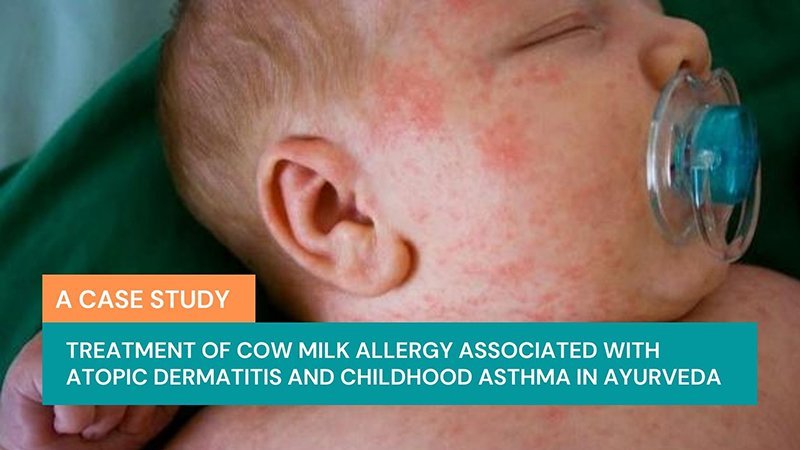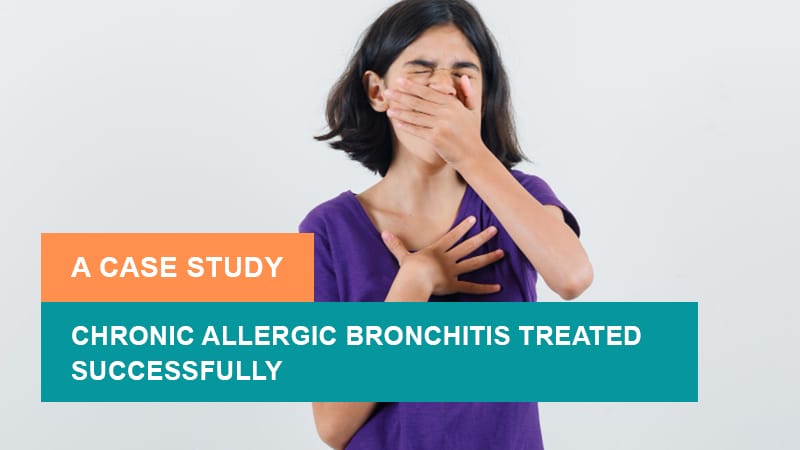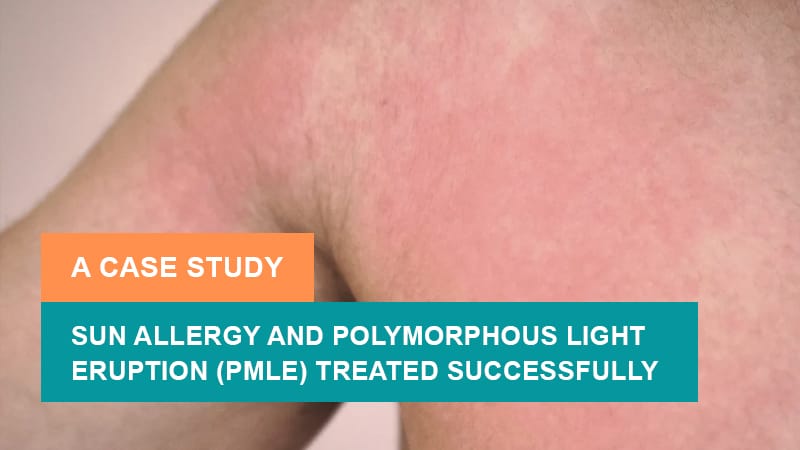Cow milk allergy in children can be successfully treated with a high success rate by various Ayurveda treatment measures. Dr. Sahil Gupta the well-known Ayurvedic Allergy Specialist, founder of Institute of Applied Food Allergy® has successfully treated thousands of cow milk allergy patients around the world. Ayurvedic treatment of Cow milk allergy is one among IAFA’s successful measures. This blog is a case study of Cow milk allergy successfully treated in IAFA®.
Abstract
Cow Milk Allergy, also known as Cow’s Milk Protein Allergy (CMPA), is one of the most common food allergies seen in infants and children. A case report of 9 years old female child, who presented with complaints of atopic dermatitis and childhood asthma along with cow milk allergy, has been presented here. On diagnosis, it was found that she had been suffering from cow milk allergy which resulted into the onset of symptoms of atopic dermatitis and later she developed childhood asthma. In her case, there is a progression of allergic disorders which is known as Allergy March. In Ayurveda, cow milk allergy can be correlated to Ksheeraalasaka. Parents of child opted for Ayurvedic treatment for food allergies at IAFA and the child showed improvement in all the symptoms after taking treatment from IAFA. The Ayurvedic treatment has not only cleared the symptoms but no recurrence manifested. The present case will put forward the concept of food allergy associated with other skin and respiratory ailments and its line of treatment in Ayurveda.
Keywords: Food Allergy, Cow Milk Allergy, Childhood Asthma, Ksheeraalasaka, Vicharchika, Swasa Roga.
Introduction
Food allergy is an immune reaction that occurs soon after eating a particular food. The most common allergens include wheat, peanuts, milk and milk products. It is an abnormal response by the body’s immune system to milk and milk products. An allergic reaction usually occurs soon after consuming milk. Milk allergy is an adverse immune reaction to one or more than 12 proteins present in milk but it is predominantly prevalent against alpha S1-casein protein in cow’s milk. In Ayurveda, it can be correlated to Ksheeraalasaka. Mostly food allergy symptoms occur within two or three hours of ingestion. Delayed reactions are typically seen in children who develop atopic dermatitis or any skin related ailment. In Ayurveda, the disease atopic dermatitis is described by the name Vicharchika. The predominant dosha involved in this condition is Kapha.
The present paper deals with the case report of 9 years old child who came to IAFA for the Ayurvedic treatment of food allergies. Her parents got the reference of IAFA from Goggle as they were searching for best Ayurvedic treatment of food allergies on the internet. Institute of Applied Food Allergy® (IAFA®) was founded by Dr. Sahil Gupta in the year 2008. IAFA®, with years of experience has become the Ayurvedic leaders in allergic disorders management with the help of natural herbs for food allergies. Dr. Gupta became the first doctor who knows well how to treat food allergies naturally.
Ayurvedic Concept
In Ayurveda, the term Asatmya is used which means intolerance to something. Aahar Asatmyata term in Ayurveda is defined as Food intolerance. It occurs due to low agni (weak digestive fire) which becomes low due to accumulation of ama visha (toxins). In Ayurveda, it is said that the digestive tract and immune system are interlinked. Ksheeraalasaka as described in Ayurveda, is the manifestation of cow milk allergy. According to Ayurveda, no disease can occur without vitiation of Doshas. Thus, line of treatment should be according to the causative Dosha. Dugdha as per Ayurveda aggravates Kaphadosha.
Case Description
- Patient name: Aishi
- Age: 9 years/female
- Address: Haryana (India)
- UID: 5511
- Date of registration: 13th September, 2020
Diagnosis
Atopic Dermatitis and Childhood Asthma with cow milk allergy
Aishi, came to IAFA with complaints of itchy skin which is more common over flexors of foot and frequent attacks of childhood asthma which has been presented here. The parents of child were not aware of cow milk allergy and they kept on giving her cow milk. After 1-2 years, she developed atopic dermatitis and during the age of 5, she started getting recurrent events of wheezing with shortness of breathing. She had to be hospitalized whenever her respiratory symptoms were more worsened. Dr. Gupta at IAFA, after doing Ashtavidha Pareeksha gets the accurate diagnosis that atopic dermatitis and childhood asthma is an allergic progression due to food allergy. He suggested her for a food intolerance test to find out the accurate food allergens.
Allergen Details
As per her food intolerance test which was done on 16th October, 2020, the allergens were:
- Almonds
- Curd
- Msg (Ajinomoto)
- Cheese
- Dal Chana
- Orange
- Cocoa
- Milk
- Rice
- House Dust Mite
- Dog Dander
- Allopathic Drug Paracetamol
Symptoms
Gastrointestinal symptoms:-
- Colicky pain
- Regurgitation
- Nausea
- Constipation with or without perianal rash
Skin:-
- Atopic dermatitis
- Itchiness which is more prominent over flexors of foot
- Dry skin
Respiratory tract:-
- Rhinitis
- Chronic cough
- Wheezing
- Frequent attacks of childhood asthma which needs hospitalization to settle.
Click here to View Full Report
Diagnosis
The diagnosis of multiple food allergies requires careful recording of the history of the patient’s symptoms as well as his food habits. The main objective of the treatment was to manage food allergy and to prevent allergic progression.
Treatment Plan
The treatment of child was started on 13th September, 2020 by IAFA. The medications were given for 1 month. The primary focus of the treatment was to resolve respiratory issues and allergic responses that the child was going through. So, ayurvedic formulations were prescribed that works on respiratory system disorders, skin ailments and allergies and herbal remedies for topical use.
- Total Care 3X Ra – 10 ml twice in a day with water.
- Respiratory Care X drops – 10 drops twice a day with water.
- Respiro Detox Formula – 2 gm twice in a day with honey.
- E-5 Cell Repair Oil for local application on the affected area.
- IAFA Skin Fresh Bar for bath.
1. Total Care 3X Ras
Total Care 3X Ras of IAFA is a wonderful herbal remedy for the treatment of respiratory system disorders, skin ailments and allergies. The ingredients of Total Care Ras are:
- Satyanashi (Argemone mexicana): Satyanashi, commonly known as Mexican poppy acts as shodhani (cleansing). It is useful in fever, inflammation, toxic conditions etc.
- Dronapushpi (Leucas cephalotes): Dronapushpi is indicated in the treatment of respiratory disorders such as childhood asthma, cough, cold etc. due to its anti-inflammatory, microbial and analgesic properties.
- Sirisha (Albizia lebbeck): The leaves of Sirisha have astringent, anti-histaminic and astringent actions. These are useful in treating childhood asthma, allergic rhinitis, cough, chronic cold, bronchitis and allergies.
- Bhoomiamla (Phyllanthus niruri): Bhoomiamla has Kapha and Pitta balancing property. This helps in reducing cough, cold and breathing problems such as childhood asthma, breathlessness etc.
- Vasa Putapaka (Adhatoda vasica): Vasaka is an ultimate remedial measure for all kinds of respiratory troubles such as difficulty in breathing, cough, cold, nasal congestion, childhood asthma, bronchitis and other respiratory tract infections.
- Dugdhdika (Euphorbia hirta): Dugdhdika, commonly known as asthma plant is used in the treatment of childhood asthma, bronchitis, dysentery, diarrhoea etc.
- Yavakshara (Hordeum vulgare): Yavakshara is an alkali preparation from the barley plant which is useful in cough, obstruction in throat, balances Kapha and Vatadosha etc.
- Yashtimadhu (Glycyrrhiza glabra): Yashtimadhu is commonly known as mulethi, is a good expectorant, expels phlegm from the lungs and heals respiratory disorders.
2. Respiratory Care X Drops
IAFA provides an efficient herbal remedy for kids that have been used in Ayurveda since ages for giving strength to respiratory system including childhood asthma and allergies. Ingredients of Respiratory Care X Drops are:
- Vasa (Adhatoda vasica): Vasa is considered as a drug of choice in respiratory disorders. It acts as bronchodilator, expectorant etc.
- Yashtimadhu (Glycyrrhiza glabra): Yashtimadhu, commonly known as mulethi is an effective bronchodilator as it helps in dilating the bronchioles. Therefore, it is useful in treating shallow breathing in chronic respiratory ailments.
- Surssa (Ocimum sanctum): The other name of Surssa is tulsi. It possesses anti-asthmatic, anti-inflammatory and anti-microbial properties. It is a well-known traditional herb for all sorts of respiratory tract problems.
- Jivanti (Leptadenia reticulata): Jivanti is a wonderful herb famous for its restorative property. It is also an important constituent of many ayurvedic formulations such as chywanprash. The leaves and roots of this plant are used in skin infections, childhood asthma and ear disorders.
- Kanthkari (Solanum surattense): Kanthkari is well-known in Ayurveda for its expectorant property. It has the properties such as anti-inflammatory, expectorant, demulcent and anti-microbial. It releases mucus from the respiratory tract and prevents recurrent asthmatic attacks.
- Ela (Elettaria cardamomum): The common name of Ela is cardamom. Ela has anti-allergic and anti-inflammatory properties. It can be effectively used for treating allergic conditions. In Ayurveda, it is categorized under herbs that are useful in childhood asthma and dyspnoea.
- Haridra (Curcuma longa): Haridra is a common household spice in India. It is used in many forms and through many routes of administration such as nasal, oral application on the skin etc.
- Bhumi Amalaki (Phyllanthus niruri): Bhumi Amalaki has immunological property as it balances Kapha and Pitta doshas. It is beneficial in the conditions such as allergies, cough, bronchitis, nasal allergies etc.
- Bruhati (Solanum indicum): Bruhati is useful in the treatment of respiratory tract problems as it provides strength to the respiratory organs. It has immune boosting property as well.
- Agaru (Aquillaria agallocha): Agaru is a fragrant tree, commonly known as agarwood. It is categorized under the group of herbs that relieves childhood asthma and bronchitis.
3. Respiro Detox Formula
IAFA Respiro Detox Formula is a unique combination of minerals which supports free breathing, keeps airway open and supports seasonal comfort as well. Ingredients of Respiro Detox Formula are:
- Giloy Satv: Giloy Satv is an herbal powder prepared from Tinospora cordifolia stem. It boosts immunity and acts as an antioxidant.
- Tankan Bhasam: Tankan Bhasam is an Ayurvedic mineral formulation useful in coughing, bronchitis, wheezing and breathing problems.
- Saftik Bhasam: Saftik Bhasam is prepared from alum (phitkari). In Ayurvedic medicine, it is useful in chronic cough, tuberculosis, childhood asthma and other breathing problems.
- Godanti Bhasam: Godanti Bhasam is an Ayurvedic mineral-based medicine prepared from gypsum. It is beneficial in high-grade fever, non-productive cough etc.
- Abhrak Bhasam: Abhrak Bhasam is calcined mica ash useful in respiratory disorders such as childhood asthma, difficulty in breathing, chronic cough, whooping cough etc.
4. E-5 Cell Repair Oil
E-5 Cell Repair Oil by IAFA is a unique preparation that repairs damaged skin cells. It is specially formulated under experts of Institute of Applied Food Allergy® by carefully chosen herbal ingredients. The ingredients of E-5 Cell Repair Oil are:
- Karanj (Pongamia glabra): The herb Karanj is mainly used for skin disorders. All parts of karanj tree such as roots, flowers, leaves and bark are used for medicinal purposes. Its oil is applied on the skin to treat the problems such as eczema, boils as well as to heal wounds due to its ropan (healing) property).
- Sirisha (Albizia lebbeck): The bark, seeds, leaves and flowers of sirisha are used for medicinal purposes. It is good for skin disorders as it detoxifies the skin, relieves itching and pruritis.
- Darvi (Berberis aristata): The anti-inflammatory and anti-psoriatic properties of daruhaldi makes it a suitable herb for the treatment of skin disorders like atopic dermatitis. This herb is also useful in protecting liver.
- Aragwadha (Cassia fistula): In Ayurveda, aragwadha is widely used in the treatment of skin disorders due to its detoxifying property.
- Coconut Oil (Cocos nucifera linn.): Coconut oil is extensively useful in skin disorders due to its Pitta balancing property.
5. IAFA Skin Fresh Bar
IAFA Skin Fresh Bar is a unique preparation of carefully chosen herbal ingredients such as Sweta Kutaj, Neelini and Kumari and the herbs like Lodhar, Nimba, Chakramarda etc. which are anti-microbial in nature. These herbs have antioxidant, anti-allergic and anti-inflammatory properties. It is also fortified with 7 essential oils such as Avocado oil, Almond oil Pongamia oil, Wheat germ oil, Manjistadi oil, Castor oil and Coconut oil making it a suitable choice for dry, itchy, flaky and inflamed skin.
19th October, 2020
On 19th October, 2020 the patient revisited at IAFA and following medications were administered:
- Haridra khandam – half teaspoon twice in a day.
- Laxmi Vilas Ras – 125 mg once in a day with water.
- Total Care 3X Ras – 10 ml twice in a day with water.
- Respiratory Care X drops – 10 drops twice in a day with water.
- Respiro Detox Formula – 2 gm twice a day with honey.
- E-5 Cell Repair Oil for local application on the affected area.
- IAFA Skin Fresh Bar for bath.
1. Haridra khandam
Haridra khandam is widely used in allergic conditions in Ayurveda. The main component of Harindra khandam is turmeric. Turmeric is a rich source of antioxidants. The other ingredients present in it have the similar action as antihistaminic drugs. Thus, it is a great ayurvedic medicine for skin disorders and allergies.
2. Laxmi Vilas Ras
Laxmi Vilas Ras is a classical Ayurvedic medicine useful in respiratory related disorders. It has anti-pyretic property as well.
The child’s follow up was continued and following treatment was given up to December 31, 2020. The patient was advised to rotate positive foods every 5 days in an alternate manner. No adverse effects were seen in patient with herbal formulations.
January 1, 2021
The patient revisited IAFA on January 1, 2021. The patient got relief with these ayurvedic medicines as her symptoms subsided without any side effects. Now she was administered herbal remedies preferably for cow milk allergy for next 3 months. The following treatment was given:
- Aahar Amrutam Bindu – 10 drops to be taken twice daily with water.
- Aahar Amrutham Ras – 10 ml twice in a day with water.
- Haridra khandam – half teaspoon twice in a day.
- E-5 Cell Repair Oil for local application on the affected area.
- IAFA Skin Fresh Bar for bath.
1. Aahar Amrutam Ras
Aahar Amrutam Ras is an Ayurvedic herbal formulation manufactured by IAFA for the successful management of food allergies. The major ingredients of Aahar Amrutam Ras are:
- Chotti Dudhi (Euphorbia thymifolia): Chotti Dudhi is an Ayurvedic herb commonly used in the treatment of diarrhoea, dysentery, abdominal pain, worm infestation, childhood asthma, bronchitis, skin disorders etc.
- Shrifal (Aegle marmelos): Shrifal fruit is extensively described in ancient literature and it is one among the dashmoola herbs. It is anti-inflammatory in nature, acts as an absorbent, improves digestion, astringent in nature and useful in diarrhoea and dysentery.
- Bhoomiamla (Phyllanthus niruri): Bhoomiamla is considered as a liver protecting herb in Ayurveda. It is useful in anorexia and chronic dysentery as it is appetiser and anodyne in nature.
- Punarnava (Boerhavia diffusa): Punarnava is well-known for its swelling reducing property in Ayurveda. It is deepani in nature i.e., it improves digestion strength and useful in chronic toxic conditions.
In addition to the above treatment, some changes in diet were also advised such as intake of warm and fresh food, adequate sleep, consumption of properly cooked food and avoid excessively spicy, salty and sour food, dairy products, junk food, mixture of non-vegetarian food with milk and other sweet items.
With the follow up period of 5 months on 10th March, 2021, the child has shown no signs of recurrence and her treatment plan was stopped. Meanwhile, she was advised to continue Ahara Amrutham drops for one year, E-5 Cell Repair Oil for local application and IAFA Skin Care Fresh Bar for long term use.
Discussion
In the present case, the child was suffering from allergy march as there was a progression of allergic disorders. The first step of allergic march is food allergy. The end points of allergic march are allergic rhinitis and childhood asthma. There are various studies that have shown the relationship between food allergy, atopic dermatitis and childhood asthma.
Conclusion
Cow milk allergy is a disorder of the immune system having its impact on whole life of child. Ayurvedic line of management by IAFA aims to give a healthy and happy life to the child by improving the functioning of her immune system by removing the toxins and boosting the digestive fire. Thus, Ayurvedic treatment of food allergies is absolutely safe for children and seems to be effective in the successful management of food allergies which are chronic in nature. The parents of child are thankful to IAFA.







